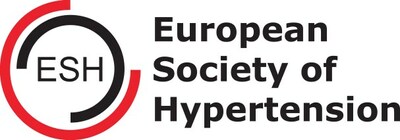MILAN, June 28, 2023 /PRNewswire/ -- The European Society of Hypertension (ESH), the leading hypertension society in Europe, released updated and expanded 2023 ESH Guidelines for the Management of Arterial Hypertension during three oral presentations at the 32nd Annual European Meeting on Hypertension and Cardiovascular Protection Meeting in Milan, Italy. The full guidelines will be published in the August issue of the Journal of Hypertension. The new guidelines are designed to serve as an essential resource on the latest scientific evidence for healthcare professionals around the world that treat individuals with hypertension.

Arterial hypertension (elevated blood pressure) is a common and leading preventable cause of heart attack, stroke, kidney failure and death that impacts 1.28 billion adults worldwide. Some risk factors for hypertension include obesity, poor diet, lack of exercise and stress. Arterial hypertension constitutes the most prevalent and important risk factor for cardiovascular morbidity and mortality globally despite the availability of effective pharmacological treatments. In addition, approximately half of individuals with hypertension do not meet guideline-directed blood pressure (BP) goals. While medication and lifestyle changes can help decrease hypertension, they alone are sometimes not enough.
"At ESH, we see the impact of this public health crisis first-hand and want to share real-world, evidence-based recommendations to address this silent killer, which is still underdiagnosed and often difficult to treat," said Giuseppe Mancia, Emeritus Professor of Medicine, University Milano-Bicocca, Italy and Chair of the guidelines.
The comprehensive ESH guidelines were written and approved by a diverse panel of European hypertension specialists for practicing physicians and healthcare professionals with hypertensive patients.
Highlights include:
Updated Measurement & Monitoring Protocols
- Updated definition, classification, and recommendations for measurement and monitoring of hypertension and BP including office BP targets for most adults
- Systolic BP Target Range 140 – 120 mmHg
- Diastolic BP Target Range 80-70 mmHg
Expanded Lifestyle Changes in the Management of Hypertension
- Role and practical guidance for the implementation of
- physical activity and exercise
- dietary changes
Novel and Simplified Guidance for Prescribing Patterns for Drug Treatment
- Start with dual combination therapy in most patients
- Uptitrate to maximum well-tolerated doses and to triple therapy if needed
- Once daily (preferred in the morning)
- Add further drugs if needed
- Preferred use of SPCs at any step
Selection of Major Drug Classes
- Preferred use of RAS blockers, Calcium-Channel-Blockers, and Thiazide/Tthiazide-like diuretics, and their various combinations for blood pressure-lowering treatment.
- Inclusion of beta-blockers among the major antihypertensive drugs and identification of multiple conditions supporting their use in clinical practice.
- Positioning of novel drugs including SGLT2 inhibitors and non-steroidal MRA
Innovations in the Treatment of Hypertension
- A novel definition of recommendations for the management of true resistant hypertension including the use of renal denervation (RDN).
- RDN can be considered as an additional therapy in patients with true resistant hypertension and an eGFR of at least 40ml/min/1.732
- RDN can also be considered as a treatment option in patients with uncontrolled hypertension and an eGFR of at least 40ml/min/1.732, despite the use of antihypertensive drug combination therapy, or if drug treatment elicits serious side effects and poor quality of life.
Novel Treatment Algorithms
New approaches to reach patients with chronic conditions including:
- Heart failure
- Chronic kidney disease
- Secondary forms of hypertension
Expanded Screening & Management Recommendations Across Patient Populations
- Expanded patient population risk factors, criteria and recommendations for patients by gender, sex and life stage including women, older adults, young adults and children/adolescents
- Detailed recommendations on patient follow-up strategies, including assessment and minimization of non-adherence and clinical inertia.
"These new guidelines offer a roadmap for creating a customized approach for treating different patient populations and overcoming patient inertia," said Professor Reinhold Kreutz, Charité - University Medicine Berlin, Berlin, Germany and co-chair of the guidelines. "For the first time, recommendations around a wide spectrum of important co-morbidities including the impact of COVID-19 offer a more complete picture of how to manage hypertension with multiple factors at play."
Video presentations with guideline co-authors will be available through the ESH website.
About the European Society of Hypertension Meetings
The annual European Hypertension Meetings offer the highest quality scientific programs related to research in Basic and Clinic areas and Clinical Management in Hypertension with State-of-the-Art Lectures, Satellite Symposia, Teaching Sessions and credits for qualifying as Hypertension Specialists of the European Society of Hypertension.
Media Contact:
Amy Burdick
aburdick@brgcommunications.com
703-739-8343
SOURCE European Society of Hypertension

